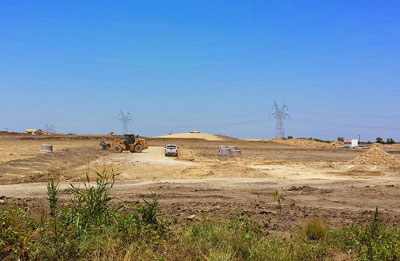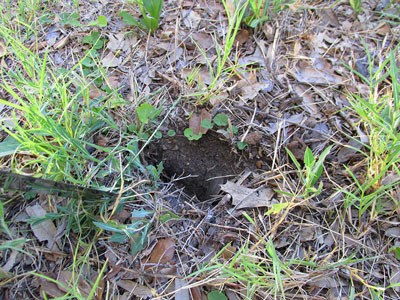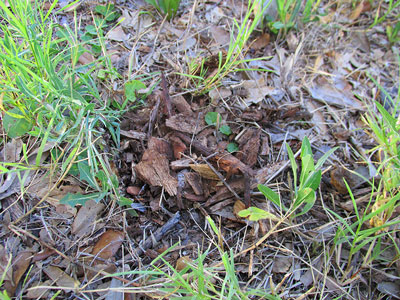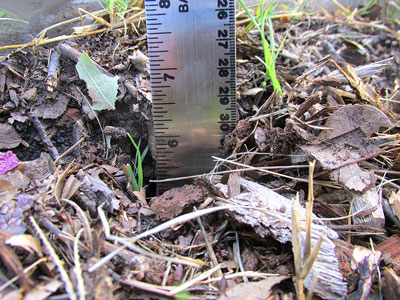Texas Tree Tips: September 2014

Most urban soils are disturbed as neighborhoods are developed, depriving newly planted trees of nature’s organically rich soils original to the site. Photo courtesy of RuthAnn Jackson.
by Steve Houser
Vertical Mulching and Composting
One way to be your trees’ best friend
To be your trees’ best friend, be respectful of the fact that trees clean our air, water, and soil. They add greatly to our health, our sense of well-being, the quality of our lives, and our economic future. A tree is not just a pretty, green object in the yard, but rather a living and breathing organism that deserves some level of respect and support. To be a best friend means understanding the needs of your friends and helping them along. They respond well to the right kind of attention. This includes giving them a big hug! (OK … so you are not a tree hugger, but it helps your tree. How about a small hug when the neighbors are not watching?)
If you ask anyone in the green industry about the one most important factor in keeping plants and trees healthy, he or she will most likely explain that the secret is always in the soil. The composition of your soil is a major factor in determining not only what trees will grow but also how well they will grow. I will blab about soil structure another day. However, since you cannot change your soil type, consider how to improve what you already have.
Most tree species prefer a thin layer of organic material near the soil’s surface, which over time stimulates a great deal of biological activity in the soil layers in the trees’ root zones. Organic material, such as leaves and twigs slowly breaking down on the surface of the soil, amounts to good medicine for a tree.
On a rural property or one with no maintenance, leaves, twigs, limbs, and even trunks are lying on the soil. This helps to conserve moisture and provide organic material, which is broken down by soil microorganisms. Of course, some rural properties can be void of organic material due to previous farming, ranching, fire, or other causes. Be a best friend to your trees: leave the organic material underneath the canopy, and replace it if it has been lost.
If you live in an urban area, leaving dead limbs in place can certainly earn you the title of the neighborhood tree hugger. However, the soil around your home likely needs organic material to reestablish its health and build a layer of good topsoil over time. Why? Because the good organic material and topsoil are often removed as neighborhoods are developed, leaving soil that is not the “good stuff.”
You can regenerate the “good stuff” by adding organic material inside the drip line of a tree. Apply a quarter-inch layer of finished compost and a one-inch layer of chip mulch. Compost adds elements to the soil that benefit trees and plants. Don’t place either of these materials against the trunk or on the tree’s root flare, since both should always be left exposed. A 6- to 8-inch buffer zone at the tree’s base is sufficient. As these materials break down over time, be a really best friend and replace them with a little more compost and mulch.

The cracks in dry black soils provide an easy opportunity to add compost and mulch to the soils in a tree’s root zone. This and all other photos courtesy of Steve Houser.
If you want your tree to consider you to be part of the family, try giving your crown jewel a little vertical mulching or composting. Carefully create small holes in the soil with a thin hand trowel, soil probe, a piece of rebar, or other small and narrow hand tool. A depth of 4 to 6 inches is a great benefit, with up to 12 inches being ideal. Gently plunge the tool into the soil, but stop if you hit anything solid — as it could be a root, underground line, or something to avoid. The holes should be inside the dripline created by the outer limbs and every 2 to 4 feet on a square grid pattern but no closer than 6 to 10 feet from the base of larger trees, since these areas may contain larger roots that can be damaged. Professional arborists often use a pneumatic air tool to create the holes and to avoid damaging roots.

Compost and mulch can be worked into cracks in the soil with a hand scoop or a garden rake.
Backfill the holes with finished (or completed) compost or mulch. Vertical mulching or composting reconditions your soil faster than surface applications. It also helps to hold moisture deeper in the soil, which allows better water penetration.

Deep cracks in the soil provide an opportunity to add organic material into the soils that serve a tree’s root zone.
Here’s the tip of the day: Around this time of year, the soil often cracks and opens fissures that are up to 10 inches or more deep in clay soils. Allowing smaller cracks to appear in the soil is not a problem for older or larger trees, and it encourages a deeper root system. Point being, this is a great opportunity to be lazy and avoid all the work noted above by backfilling the cracks with compost or mulch. Call it couch potato vertical mulching!
